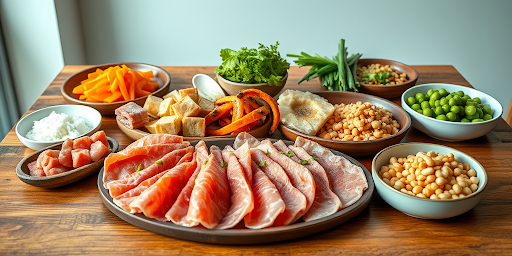Do you ever wonder if adjusting your protein intake could be the secret to targeting stubborn belly fat? High-protein diets trigger mechanisms that boost metabolism, enhance satiety, and support muscle preservation. This article unveils the scientific rationale behind protein’s role in fat reduction, revealing how nutrient timing and metabolic support can transform your approach to weight management. Prepare to explore evidence-based insights that challenge conventional wisdom and empower you to harness nutrition for optimal body rhythm and energy balance.
High-Protein Diets and Belly Fat: Effective Strategies for Fat Reduction
High-protein diets promote targeted fat reduction by influencing key metabolic and hormonal pathways. Scientific research shows that protein intake boosts satiety by reducing ghrelin and increasing peptide YY, which helps lower overall calorie consumption. In addition, the thermic effect of food from protein consumption burns an extra 80 to 100 calories daily, sometimes reaching up to 260 calories on higher intake days. Such metabolic benefits contribute to a reported 53% greater reduction in body fat over one year among individuals incorporating high-protein strategies into their diets.
To implement these benefits effectively, follow these step-by-step strategies:
- Increase your protein ratio by aiming for approximately 30% of your daily caloric intake from protein sources.
- Plan balanced meals that incorporate lean protein at every opportunity, ensuring a steady release of energy.
- Time nutrient intake to optimize satiety; consider consuming protein-rich foods at the beginning of your day and after workouts.
- Monitor your overall calorie deficit, leveraging protein’s thermic effect to support your fat-loss objectives.
Integrate these strategies into a sustainable eating plan by consistently scheduling protein-rich meals and snacks throughout your day. Focus on both animal and plant-based proteins to ensure diverse amino acid profiles and essential nutrients. Adjust your meal planning as needed, paying close attention to hunger signals and energy levels. By committing to a systematic approach and regularly reviewing your progress, you can harness the power of protein to achieve targeted belly fat reduction and improved body composition.
High-Protein Diets and Belly Fat: Integrating Nutrition with Exercise

You leverage both nutrition and exercise to maximize results, as protein consumption preserves lean mass and complements resistance training. With a high-protein diet, you provide the necessary amino acids that repair and build muscle, which increases metabolic rate and accelerates fat-burning. This synergy ensures that exercise routines not only support energy expenditure but also reduce the risk of muscle loss during weight reduction.
- Resistance training reinforces muscle strength and growth
- HIIT boosts cardiovascular capacity and increases calorie burn
- Core strengthening improves stability and targets abdominal fat
- Moderate cardio sessions complement energy expenditure
The timing of nutrient intake is as critical as the workout itself. Consuming protein shortly after exercise initiates muscle recovery and maximizes the protein synthesis process. You should schedule your workouts to coincide with meals that are high in protein, ensuring that recovery phases are not compromised. Adequate rest and structured recovery further support hormonal balance and effective fat burning. By integrating strategic exercise routines with timely protein consumption, you optimize muscle preservation and create a conducive metabolic environment for reducing stubborn belly fat.
High-Protein Diets and Belly Fat: Practical Meal Solutions and Success Stories

A protein-rich meal plan not only supports sustainable weight management but also combats the frustration of failed diets. By emphasizing high-protein recipes, you create a nutritional environment that aids in reducing belly fat while maintaining muscle mass. Research highlights that well-planned meals featuring lean proteins can lead to a 50% decrease in weight regain over long-term periods. Incorporating protein in every meal stabilizes energy levels, increases satiety, and fosters better dietary adherence. These benefits have inspired success stories from people who have shifted away from inconsistent dieting towards structured protein-based meal solutions.
- Plan an energizing breakfast smoothie using protein powder, spinach, and berries to kickstart metabolism.
- Prepare overnight oats topped with Greek yogurt and nuts for sustained morning energy.
- Create balanced lunch bowls with quinoa, grilled chicken, assorted vegetables, and a drizzle of olive oil for a nutrient-dense midday boost.
- Enjoy nutrient-packed snacks like cottage cheese with sliced fruit, which help manage hunger between meals.
- Experiment with lean protein wraps filled with turkey, avocado, and fresh greens to keep your energy balanced throughout the day.
| Meal Idea | Key Protein Source | Benefits |
|---|---|---|
| Breakfast Smoothie | Protein Powder | Boosts metabolism and satiety |
| Overnight Oats | Greek Yogurt | Maintains energy levels and reduces cravings |
| Balanced Lunch Bowl | Grilled Chicken | Supports muscle maintenance and nutrient intake |
| Protein Wrap | Lean Turkey | Provides steady energy and curbs hunger |
Integrating these practical meal ideas into your daily routine can transform your approach to dieting. Clear, actionable strategies like these empower you to break free from the cycle of failed diets, offering a path to sustainable weight management. By choosing nutrient-dense meals consistently, you benefit from improved energy levels and reduced abdominal fat, as seen in inspiring success stories. Experiment with these suggestions, adapt them to your lifestyle, and watch as your commitment to a high-protein diet paves the way for lasting, positive changes in body composition.
Final Words
In the action, you explored the scientific principles of protein’s role in energy and fat metabolism.
You reviewed effective strategies, optimal protein sources, and harmonizing nutrition with exercise.
These insights offer practical steps for refining your diet and boosting muscle support while reducing stubborn fat.
By applying this approach, you can fine-tune your eating habits and elevate your results.
Remember, High-Protein Diets and Belly Fat: What You Need to Know empowers you to achieve balanced nutrition and lasting fat loss.
FAQ
Q: Will a high-protein diet help reduce belly fat?
A: A high-protein diet effectively targets belly fat by increasing metabolism and reducing hunger. Research shows it can lead to 53% greater reduction in body fat over one year when combined with proper nutrition.
Q: What’s the optimal daily protein intake for weight loss?
A: For weight loss, aim for 0.7-0.9 grams of protein per pound of body weight daily. This amounts to approximately 105-135 grams for a 150-pound individual to support muscle maintenance and fat reduction.
Q: What is the 30-30-30 rule for protein meals?
A: The 30-30-30 rule suggests consuming 30 grams of protein within 30 minutes of waking up and exercising for 30 minutes. This approach helps regulate blood sugar and enhances metabolic function.
Q: Which protein sources are most effective for belly fat loss?
A: Lean proteins like chicken (31g/100g), yellowfin tuna (30g/100g), and plant-based options like seitan (25g/100g) are most effective. These sources provide essential amino acids while maintaining caloric control.
Q: How should I time protein intake for maximum fat loss?
A: Space protein intake evenly throughout the day in 25-30g portions. Including protein at breakfast and post-workout maximizes muscle synthesis and supports consistent fat burning.
Q: Can combining protein with exercise enhance belly fat reduction?
A: Yes, pairing high-protein intake with resistance training and HIIT exercises accelerates belly fat reduction. This combination preserves muscle mass while optimizing fat metabolism.


